
History of Vladivostok
Encyclopedia

Vladivostok
The city is located in the southern extremity of Muravyov-Amursky Peninsula, which is about 30 km long and approximately 12 km wide.The highest point is Mount Kholodilnik, the height of which is 257 m...
can roughly be divided into the history of the territory where Vladivostok is located and into the history of the city per se.
Influences
The area that is now Vladivostok was successively settled by ancient peoples and kingdoms such as the Mohe, Bohai Kingdom, and later, Liao DynastyLiao Dynasty
The Liao Dynasty , also known as the Khitan Empire was an empire in East Asia that ruled over the regions of Manchuria, Mongolia, and parts of northern China proper between 9071125...
and Jīn Dynasty
Jin Dynasty
Jin Dynasty may refer to:* Jin Dynasty , Chinese dynasty, subdivided into the Western and Eastern Jin periods* Later Jin Dynasty , one of the Five Dynasties during the Five Dynasties and Ten Kingdoms Period in China.* Jin Dynasty , a Jurchen kingdom in northern China* Later Jīn Dynasty, or...
.
On Chinese maps of Yuan Dynasty
Yuan Dynasty
The Yuan Dynasty , or Great Yuan Empire was a ruling dynasty founded by the Mongol leader Kublai Khan, who ruled most of present-day China, all of modern Mongolia and its surrounding areas, lasting officially from 1271 to 1368. It is considered both as a division of the Mongol Empire and as an...
(1271-1368) it is called Yongmingcheng (永明城 [Yǒngmíngchéng], literally "city of eternal light"). During the Ming Dynasty
Ming Dynasty
The Ming Dynasty, also Empire of the Great Ming, was the ruling dynasty of China from 1368 to 1644, following the collapse of the Mongol-led Yuan Dynasty. The Ming, "one of the greatest eras of orderly government and social stability in human history", was the last dynasty in China ruled by ethnic...
(1368-1644) it was visited by Chinese expeditions, and a relic of that time — a Chongning
Emperor Huizong (Song Dynasty)
Emperor Huizong was the eighth and one of the most famous emperors of the Song Dynasty of China, with a personal life spent amidst luxury, sophistication and art but ending in tragedy....
stela — is displayed in the local museum. The Treaty of Nerchinsk
Treaty of Nerchinsk
The Treaty of Nerchinsk of 1689 was the first treaty between Russia and China. The Russians gave up the area north of the Amur River as far as the Stanovoy Mountains and kept the area between the Argun River and Lake Baikal. This border along the Argun River and Stanovoy Mountains lasted until...
of 1689 defined the area as a part of China, under the Manchu
Manchu
The Manchu people or Man are an ethnic minority of China who originated in Manchuria . During their rise in the 17th century, with the help of the Ming dynasty rebels , they came to power in China and founded the Qing Dynasty, which ruled China until the Xinhai Revolution of 1911, which...
Qing Dynasty
Qing Dynasty
The Qing Dynasty was the last dynasty of China, ruling from 1644 to 1912 with a brief, abortive restoration in 1917. It was preceded by the Ming Dynasty and followed by the Republic of China....
. Later on, as the Manchus banned Han Chinese
Han Chinese
Han Chinese are an ethnic group native to China and are the largest single ethnic group in the world.Han Chinese constitute about 92% of the population of the People's Republic of China , 98% of the population of the Republic of China , 78% of the population of Singapore, and about 20% of the...
from most of Manchuria
Manchuria
Manchuria is a historical name given to a large geographic region in northeast Asia. Depending on the definition of its extent, Manchuria usually falls entirely within the People's Republic of China, or is sometimes divided between China and Russia. The region is commonly referred to as Northeast...
including the Vladivostok area — it was only visited by shēnzéi (參賊, lit. either ginseng or sea cucumber thieves) who illegally entered the area seeking ginseng
Ginseng
Ginseng is any one of eleven species of slow-growing perennial plants with fleshy roots, belonging to the genus Panax of the family Araliaceae....
or sea cucumbers (ambiguous since both terms use the Chinese 參, shēn). From this comes the current Chinese
Chinese language
The Chinese language is a language or language family consisting of varieties which are mutually intelligible to varying degrees. Originally the indigenous languages spoken by the Han Chinese in China, it forms one of the branches of Sino-Tibetan family of languages...
name for the city, 海參崴 (Hǎishēnwǎi) meaning "Sea Cucumber Cliffs". A French ship which is believed to have visited the area around 1858 discovered several huts of Chinese or Manchu fishermen.
Russian control
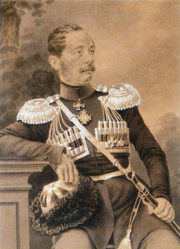
Treaty of Aigun
The Treaty of Aigun was a 1858 treaty between the Russian Empire, and the empire of the Qing Dynasty, the sinicized-Manchu rulers of China, that established much of the modern border between the Russian Far East and Manchuria , which is now known as Northeast China...
of 1858 and the Treaty of Peking of 1860.
In the summer of 1859, Governor-General of Eastern Siberia
Siberia
Siberia is an extensive region constituting almost all of Northern Asia. Comprising the central and eastern portion of the Russian Federation, it was part of the Soviet Union from its beginning, as its predecessor states, the Tsardom of Russia and the Russian Empire, conquered it during the 16th...
, Nikolay N. Muravyov
Nikolay Muravyov-Amursky
Nikolay Nikolayevich Muravyov-Amursky was a Russian statesman and diplomat, who played a major role in the expansion of the Russian Empire into the Amur River basin and to the shores of the Sea of Japan.-Surname spelling:The surname Muravyov has also been transcribed as Muravyev or Murav'ev.-Early...
, visited the peninsula and the bay, which was somewhat similar to the Bay of the Golden Horn
Golden Horn
The Golden Horn is a historic inlet of the Bosphorus dividing the city of Istanbul and forming the natural harbor that has sheltered Greek, Roman, Byzantine, Ottoman and other ships for thousands of...
in Constantinople
Constantinople
Constantinople was the capital of the Roman, Eastern Roman, Byzantine, Latin, and Ottoman Empires. Throughout most of the Middle Ages, Constantinople was Europe's largest and wealthiest city.-Names:...
(now Istanbul
Istanbul
Istanbul , historically known as Byzantium and Constantinople , is the largest city of Turkey. Istanbul metropolitan province had 13.26 million people living in it as of December, 2010, which is 18% of Turkey's population and the 3rd largest metropolitan area in Europe after London and...
), aboard the steam corvette Amerika. The peninsula was named Muravyov-Amursky in his honor.
The first Europeans to visit the local bay (later named the Golden Horn Bay
Zolotoy Rog
Zolotoy Rog Bay is a sheltered horn-shaped bay separated from the Peter the Great Gulf of the Sea of Japan by Shkota Peninsula on the north-west, Cape Goldobina on the east-north-east, and Cape Tigrovy on the west. The bay is seven kilometers long, with a width of about two kilometers and a depth...
) were two English frigates Winchester and Barrakuda in 1855.
During the rule of Joseph Stalin
Joseph Stalin
Joseph Vissarionovich Stalin was the Premier of the Soviet Union from 6 May 1941 to 5 March 1953. He was among the Bolshevik revolutionaries who brought about the October Revolution and had held the position of first General Secretary of the Communist Party of the Soviet Union's Central Committee...
, many ethnic groups that seemed rebellious in Stalin's eyes, including Chinese, Manchu, Jews, Ukrainians, Poles, Crimean Tartars, Chechens, and Armenians, were deported out as well.
Beginning of the modern city
On June 20 (July 2 Gregorian styleGregorian calendar
The Gregorian calendar, also known as the Western calendar, or Christian calendar, is the internationally accepted civil calendar. It was introduced by Pope Gregory XIII, after whom the calendar was named, by a decree signed on 24 February 1582, a papal bull known by its opening words Inter...
), 1860 the military supply ship Manchur, under the command of Captain-Lieutenant Alexey K. Shefner, called at the Golden Horn Bay to found an outpost called Vladivostok. Warrant officer
Warrant Officer
A warrant officer is an officer in a military organization who is designated an officer by a warrant, as distinguished from a commissioned officer who is designated an officer by a commission, or from non-commissioned officer who is designated an officer by virtue of seniority.The rank was first...
Nikolay Komarov
Nikolay Vasilyevich Komarov
Nikolay Vasilyevich Komarov was a Russian junior commissioned officer who is commonly considered to be the founder of the city of Vladivostok.Little is known about Komarov's youth...
with 28 soldiers and two non-commissioned officers under his command were brought from Nikolayevsk-on-Amur
Nikolayevsk-on-Amur
Nikolayevsk-on-Amur often romanized as Nikolayevsk-na-Amure, is a town and the administrative center of Nikolayevsky District of Khabarovsk Krai, Russia located on the Amur River close to its liman in the Pacific Ocean...
by ship to construct the first buildings of the future city. They pitched a camp, selecting a place from where the entrance to the Golden Horn Bay was always visible.
In 1862, under the leadership of Yevgeny Burachyok
Yevgeny Burachyok
Yevgeny Stepanovich Burachyok , 1836–1911) was a Russian seaman and the second head of the garrison of the military post of Vladivostok in 1861–1863, who significantly contributed to the post's early development....
, the outpost of Vladivostok officially became a port. To encourage foreign trade, a Free Port
Free port
A free port or free zone , sometimes also called a bonded area is a port, port area or other area with relaxed jurisdiction with respect to the country of location...
status, or a Free Trade Status for imported goods, was established. In 1864, the Command of the Southern Harbours was moved to Vladivostok from Nikolayevsk-on-Amur
Nikolayevsk-on-Amur
Nikolayevsk-on-Amur often romanized as Nikolayevsk-na-Amure, is a town and the administrative center of Nikolayevsky District of Khabarovsk Krai, Russia located on the Amur River close to its liman in the Pacific Ocean...
. A year later a Shipbuilding Yard was established in Vladivostok and the first settlers from Nikolayevsk-na-Amure began arriving. Foreigners started visiting Vladivostok. In 1871 it was decided that the Naval Port, Military Governor's Residence, and the main base of the Siberian Military Flotilla were to be moved from Nikolayevsk-na-Amure to Vladivostok. The same year the Great Northern Telegraph Company
Great Northern Telegraph Company
The Great Northern Telegraph Company was a Danish telegraph company founded in June 1869...
connected Vladivostok to Nagasaki and Shanghai
Shanghai
Shanghai is the largest city by population in China and the largest city proper in the world. It is one of the four province-level municipalities in the People's Republic of China, with a total population of over 23 million as of 2010...
by means of underwater International cable.
Vladivostok's first street was Amerikanskaya Street (ул. Американская), which was named to commemorate the above-mentioned corvette America in 1871. Two years later it was renamed Svetlanskaya Street
Svetlanskaya Street
Svetlanskaya Street is a major street in Vladivostok, Russia.-History:Svetlanskaya Street was originally called Amerikanskaya Street, but was renamed in 1873 in honor of the frigate Svetlana which brought Grand Duke Alexei Alexandrovich of Russia to the city for a visit...
(ул. Светланская), in honor of the frigate Svetlana, on which the Grand Duke Alexei Alexandrovich of Russia
Grand Duke Alexei Alexandrovich of Russia
Grand Duke Alexei Alexandrovich of Russia was the sixth child and the fourth son of Alexander II of Russia and his first wife Maria Alexandrovna . Destined to a naval career, Alexei Alexandrovich started his military training at the age of 7...
visited Vladivostok. At that time it consisted of a part of today's Svetlanskaya Street, from the Amursky Bay to house #85. Its other parts were then considered as separate streets and had the names of Portovaya (Портовая), Afanasyevskaya (Афанасьевская), Ekipazhnaya (Экипажная), etc.
In 1878, 40% of over 4,000 residents of Vladivostok were foreigners. This was reflected in the names of the young city streets, such as Koreyskaya (Korean), Pekinskaya (Peking), Kitayskaya (Chinese), etc. Their present names are Pogranichnaya (ул. Пограничная), Admirala Fokina (ул. Адмирала Фокина), and Okeansky Avenue (Океанский проспект).

Odessa
Odessa or Odesa is the administrative center of the Odessa Oblast located in southern Ukraine. The city is a major seaport located on the northwest shore of the Black Sea and the fourth largest city in Ukraine with a population of 1,029,000 .The predecessor of Odessa, a small Tatar settlement,...
, St. Petersburg
Saint Petersburg
Saint Petersburg is a city and a federal subject of Russia located on the Neva River at the head of the Gulf of Finland on the Baltic Sea...
, and Vladivostok. On April 28 (May 10 Gregorian style), 1880 Vladivostok was officially proclaimed a city, and a separate administrative unit, independent from Primorskaya Oblast. At that time the city population totalled 7,300 people, which is twice as many as in 1878. Three hotels operated in Vladivostok at that time, including Moscow, Vladivostok, and Hotel de Louvre.
In 1883, the Resettlement Administration was established in Vladivostok, and the steamships of the Russian Volunteer Fleet began a mass transport of peasants from European Russia to the Far East
Russian Far East
Russian Far East is a term that refers to the Russian part of the Far East, i.e., extreme east parts of Russia, between Lake Baikal in Eastern Siberia and the Pacific Ocean...
, where active settling had recently begun. Vladivostok became the main shipping center. This resulted in a greater increase in the city's significance. In 1888 the residence of the Oblast Governor was moved from Khabarovsk
Khabarovsk
Khabarovsk is the largest city and the administrative center of Khabarovsk Krai, Russia. It is located some from the Chinese border. It is the second largest city in the Russian Far East, after Vladivostok. The city became the administrative center of the Far Eastern Federal District of Russia...
to Vladivostok. In 1889 Vladivostok was proclaimed a Fortress, and two torpedo-boats, brought disassembled from the Black Sea
Black Sea
The Black Sea is bounded by Europe, Anatolia and the Caucasus and is ultimately connected to the Atlantic Ocean via the Mediterranean and the Aegean seas and various straits. The Bosphorus strait connects it to the Sea of Marmara, and the strait of the Dardanelles connects that sea to the Aegean...
, were launched.
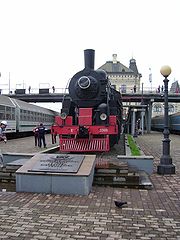
By the end of 1880s Vladivostok had approximately 600 wooden and more than 50 stone houses, some of them were two- and three-story buildings. The main urban buildings were grouped in the area of today's central square and the Matrosskaya Sloboda
Sloboda
Sloboda was a kind of settlement in the history of Russia, Belarus and Ukraine. The name is derived from the early Slavic word for "freedom" and may be vaguely translated as "free settlement"....
(Sailors' Suburb)—a territory from the Obyasneniya River as far as Gaydamak tram stop. These figures are not large for a city which was about 30 years old. But considering the fact that it is located 10,000 km from the major cultural centers of the Russian Empire
Russian Empire
The Russian Empire was a state that existed from 1721 until the Russian Revolution of 1917. It was the successor to the Tsardom of Russia and the predecessor of the Soviet Union...
and that it took three to four months for the mail to arrive from those places, one can admire the persistence and stubbornness of the first settlers.
In the 1890s, the shipping lines Kobe
Kobe
, pronounced , is the fifth-largest city in Japan and is the capital city of Hyōgo Prefecture on the southern side of the main island of Honshū, approximately west of Osaka...
–Nagasaki–Vladivostok and Shanghai–Nagasaki–Vladivostok were opened.
In 1891, the construction of the Trans-Siberian Railroad began in Vladivostok. This is one of the world's longest railroads, and has been very important for the development of many remote Russian outlying districts.
In 1897, a new Commercial Port was opened in Vladivostok and regular traffic to Khabarovsk by rail began.
In 1899, the first Far Eastern higher educational institution—the Oriental Institute—was established. Today it houses the main building of the Far Eastern State Technical University (FESTU).
From 1899 through 1909 four theaters were opened in Vladivostok. They were the Tikhy Okean Theater (the Pacific Ocean), the Public Theater, which followed the creative methods of Moscow Artistic Theater, the Zolotoy Rog Theater (the Golden Horn), the Pushkin Theater, where the guest performance by Vera Kommisarzhevskaya, a famous Russian actress, took place. In 1912 The Theater and Music Newspaper was first published.
During the Russo-Japanese War
Russo-Japanese War
The Russo-Japanese War was "the first great war of the 20th century." It grew out of rival imperial ambitions of the Russian Empire and Japanese Empire over Manchuria and Korea...
of 1904–1905 a Japan
Japan
Japan is an island nation in East Asia. Located in the Pacific Ocean, it lies to the east of the Sea of Japan, China, North Korea, South Korea and Russia, stretching from the Sea of Okhotsk in the north to the East China Sea and Taiwan in the south...
ese squadron of warships attacked the city with over a hundred shots. The Vladivostok Cruiser Group participated in the war, blocking the approaches to the besieged Port-Arthur
Lüshunkou
Lüshunkou is a district in the municipality of Dalian, Liaoning province, China. Also called Lüshun City or Lüshun Port, it was formerly known as both Port Arthur and Ryojun....
.
During the first Russian Revolution the city was involved in the conflict. In the beginning of 1906 it was even governed by the rebelling military units.
In the period between the two Russian Revolutions (1907–1917) a Railway Station of Russian architecture of the 17th century style, the city power station, two girls' schools, the School of Commerce, and Versailles Hotel were constructed. Trams began operating in the city streets. In 1909, for example, the port was visited by a total of 795 steamships, including 477 foreign ships. There were approximately 3,000 shops and stores in Vladivostok. In 1913, the local publishing houses issued 61 different books in Russian and foreign languages.
By 1917 Vladivostok had become a scientific, cultural, and industrial center, the largest in the Far East and Eastern Siberia. Many newspapers and magazines were published, and the first theater buildings of stone were constructed in the city.
After the Revolution
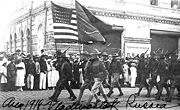
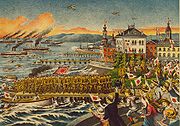
Russian Revolution of 1917
The Russian Revolution is the collective term for a series of revolutions in Russia in 1917, which destroyed the Tsarist autocracy and led to the creation of the Soviet Union. The Tsar was deposed and replaced by a provisional government in the first revolution of February 1917...
of 1917 a new stage of life began in Vladivostok, as it did in the rest of the country.
On December 31, 1917 Japanese, British
United Kingdom
The United Kingdom of Great Britain and Northern IrelandIn the United Kingdom and Dependencies, other languages have been officially recognised as legitimate autochthonous languages under the European Charter for Regional or Minority Languages...
, and American cruisers entered the Golden Horn Bay. In April 1918, the Japanese firm Isido was attacked in Vladivostok. After this incident the Japanese and British Commands landed their troops under the pretext of protecting their citizens. The Entente
Triple Entente
The Triple Entente was the name given to the alliance among Britain, France and Russia after the signing of the Anglo-Russian Entente in 1907....
soon expanded the goals of their Siberian Intervention
Siberian Intervention
The ', or the Siberian Expedition, of 1918–1922 was the dispatch of troops of the Entente powers to the Russian Maritime Provinces as part of a larger effort by the western powers and Japan to support White Russian forces against the Bolshevik Red Army during the Russian Civil War...
and sent many more troops. Canada sent 4,000 troops, with headquarters in the Pushkinskaya Theatre and barracks at Second River and Gornostai Bay.
The supporters of the Bolshevik
Bolshevik
The Bolsheviks, originally also Bolshevists , derived from bol'shinstvo, "majority") were a faction of the Marxist Russian Social Democratic Labour Party which split apart from the Menshevik faction at the Second Party Congress in 1903....
s conducted a partisan struggle in the city. From 1916 through 1922 the population of Vladivostok increased from 97,000 to 410,000 people, as a result of the opponents of the new regime settling in the port city while retreating to the East together with the White Army. Among them were many Russian cultural workers.
From 1920 through 1922, 650 representatives of the Moscow and St. Petersburg creative intelligentsia
Intelligentsia
The intelligentsia is a social class of people engaged in complex, mental and creative labor directed to the development and dissemination of culture, encompassing intellectuals and social groups close to them...
lived in Vladivostok. They established two conservatories, two theaters, and several symphony orchestras and published a number of art magazines. After the victory of Bolsheviks the majority of these people moved to Australia
Australia
Australia , officially the Commonwealth of Australia, is a country in the Southern Hemisphere comprising the mainland of the Australian continent, the island of Tasmania, and numerous smaller islands in the Indian and Pacific Oceans. It is the world's sixth-largest country by total area...
, China
China
Chinese civilization may refer to:* China for more general discussion of the country.* Chinese culture* Greater China, the transnational community of ethnic Chinese.* History of China* Sinosphere, the area historically affected by Chinese culture...
, United States
United States
The United States of America is a federal constitutional republic comprising fifty states and a federal district...
, and other countries. By 1926 the population of Vladivostok totalled 108,000 people.
On October 25, 1922 the last units of the interventionists left the city, and the units of the Red Army
Red Army
The Workers' and Peasants' Red Army started out as the Soviet Union's revolutionary communist combat groups during the Russian Civil War of 1918-1922. It grew into the national army of the Soviet Union. By the 1930s the Red Army was among the largest armies in history.The "Red Army" name refers to...
completely took control. On November 15, 1922 the Far Eastern Republic
Far Eastern Republic
The Far Eastern Republic , sometimes called the Chita Republic, was a nominally independent state that existed from April 1920 to November 1922 in the easternmost part of the Russian Far East...
, which existed from 1920 through 1922, was included into the RSFSR.
The Bolsheviks who won control of Russia understood very well the importance of Vladivostok as a major Russian port on the Pacific Coast and as an outpost of the Soviet Union in the East. In the 1920s–1930s the reconstruction of the Vladivostok port began. In the beginning of the 1930s direct air traffic to Moscow and Vladivostok began. In 1932, Vladivostok became the base of the Pacific Naval Fleet.
Science and culture acquired the spirit of that time, which was reflected in their zigzag development. In the beginning of the 1920s the Far Eastern State University was established in Vladivostok. At the end of the 1930s, during Stalin
Joseph Stalin
Joseph Vissarionovich Stalin was the Premier of the Soviet Union from 6 May 1941 to 5 March 1953. He was among the Bolshevik revolutionaries who brought about the October Revolution and had held the position of first General Secretary of the Communist Party of the Soviet Union's Central Committee...
's regime, it was closed for twenty years. In 1925, the Pacific Scientific-Commercial Station was established in Vladivostok. It was reorganized into the Pacific Scientific-Research Institute of Fisheries and Oceanography (TINRO) in 1930. In 1932 the Far Eastern Division of the Academy of Sciences of the USSR was created in the city.
In 1926, a radio station began broadcasting in Vladivostok. Three theaters and three new movie-theaters were opened in the city in 1931. The collection of the Primorye Picture Gallery was formed during 1929–1931. About 1,000 pictures were brought here from the Hermitage
Hermitage Museum
The State Hermitage is a museum of art and culture in Saint Petersburg, Russia. One of the largest and oldest museums of the world, it was founded in 1764 by Catherine the Great and has been opened to the public since 1852. Its collections, of which only a small part is on permanent display,...
, Russian Museum, and Tretyakovskaya Gallery. After the Revolution of 1917 many museums located in the Russian provinces were formed by this principle.
In the 1930s the mass repressions began in the country, and the transit camp for political prisoners carried from the Western regions of Russia to Kolyma
Kolyma
The Kolyma region is located in the far north-eastern area of Russia in what is commonly known as Siberia but is actually part of the Russian Far East. It is bounded by the East Siberian Sea and the Arctic Ocean in the north and the Sea of Okhotsk to the south...
, was opened in Vladivostok. The prisoners were arriving by trains and later transported on prison ships, in terrible conditions. The prisoners, at first Soviet, after 1939 from Eastern Europe and after the end of the World War II
World War II
World War II, or the Second World War , was a global conflict lasting from 1939 to 1945, involving most of the world's nations—including all of the great powers—eventually forming two opposing military alliances: the Allies and the Axis...
the Japanese POWs, constituted a considerable part of the labor force which built factories, ports, and cities in the Far East from 1930 through 1940.
In 1954, the First Secretary of the Communist Party of the Soviet Union, Nikita Khrushchev
Nikita Khrushchev
Nikita Sergeyevich Khrushchev led the Soviet Union during part of the Cold War. He served as First Secretary of the Communist Party of the Soviet Union from 1953 to 1964, and as Chairman of the Council of Ministers, or Premier, from 1958 to 1964...
, visited Vladivostok. Nikita Khrushchev was the first acting leader of Russia and the whole USSR, who visited the city. Khrushchev became famous worldwide for his eccentric statements and actions. He also used to compare Vladivostok with San Francisco
San Francisco, California
San Francisco , officially the City and County of San Francisco, is the financial, cultural, and transportation center of the San Francisco Bay Area, a region of 7.15 million people which includes San Jose and Oakland...
. After his visit intensive development of the city began.
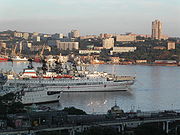
Microdistrict
Microdistrict, or microraion , is a residential complex—a primary structural element of the residential area construction in the Soviet Union and in some post-Soviet and former Communist states...
s of Vtoraya Rechka (the Second River) (since the early 1960s), Morgorodok (since the early 1960s), Churkin (since the late 1950s), and Tikhaya Bay
Tikhaya Bay
Tikhaya Bay may refer to one of the following places.*A bay of the Hooker Island, Russia.*A bay and a microdistrict in Vladivostok, Russia....
have been built intensively. Vladivostok's last large district built with the new multistory houses is the region of Patrisa Lumumby Street and Neybuta Street where the multistory construction works began in 1980.
From 1950s to the 1980s the fisheries industry was developed. For many years the ports of Vladivostok ranked first in terms of freight turnover in the Far East of Russia, having only recently yielded to Nakhodka. Vladivostok produced a large volume of military goods.
From 1930 till 1970s foreigners were not allowed
Closed city
A closed city or closed town is a settlement with travel and residency restrictions in the Soviet Union and some of its successor countries. In modern Russia, such places are officially known as "closed administrative-territorial formations" ....
to visit Vladivostok. In 1974 a historic meeting between the General Secretary of the Central Committee of the Communist Party of the Soviet Union
Communist Party of the Soviet Union
The Communist Party of the Soviet Union was the only legal, ruling political party in the Soviet Union and one of the largest communist organizations in the world...
(CPSU) Leonid Brezhnev
Leonid Brezhnev
Leonid Ilyich Brezhnev – 10 November 1982) was the General Secretary of the Central Committee of the Communist Party of the Soviet Union , presiding over the country from 1964 until his death in 1982. His eighteen-year term as General Secretary was second only to that of Joseph Stalin in...
and the president of the USA, Gerald Ford
Gerald Ford
Gerald Rudolph "Jerry" Ford, Jr. was the 38th President of the United States, serving from 1974 to 1977, and the 40th Vice President of the United States serving from 1973 to 1974...
, was held in Vladivostok. Nevertheless, after Ford's visit to Vladivostok the ordinary citizens of the USA and other countries could not visit the city, which was home base of the Pacific Fleet, for almost 20 years. In 1992, for the first time in 70 years, Vladivostok was officially opened for visits by foreigners.
In December 2008 Vladivostok protests against higher import duties on used cars were reported around the world, though with only limited coverage in Russia. These protests have been seen as potentially the first visible public anger at one of the government's responses to the global financial crisis. Police clad in riot gear detained some protesters as other demonstrators blocked roads, lit flares and bonfires in Sunday's protests that blocked traffic in the city centre. A separate protest later blockaded the city's airport for a short period.
As of 1996, there are six consulates, correspondent offices of four Japanese TV-companies, information service of the USA, more than 100 representative offices of foreign firms and approximately 600 joint venture enterprises in Vladivostok.

